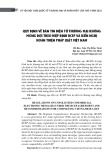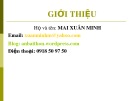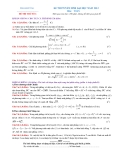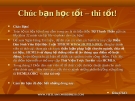CHAPTER 13
GENUINENESS OF ASSENT AND UNDUE INFLUENCE
1
© 2010 Pearson Education, Inc., publishing as Prentice-Hall © 2010 Pearson Education, Inc., publishing as Prentice-Hall
Genuine Assent
• Necessary to create an enforceable contract. • Determined by relevant facts surrounding negotiation and formation of the contract.
2
© 2010 Pearson Education, Inc., publishing as Prentice-Hall
• May be manifested in any manner sufficient to show agreement, including express words or conduct of the parties.
Genuineness of Assent (continued)
• May be lacking due to:
– Mistake
– Misrepresentation
– Duress
– Undue Influence
3
© 2010 Pearson Education, Inc., publishing as Prentice-Hall
Mistakes
• One or both of the parties have erroneous belief
about subject matter, value, or other aspect of the contract.
• Mistakes may be:
– Unilateral – Mutual
• Law may permit rescission of some contracts
4
© 2010 Pearson Education, Inc., publishing as Prentice-Hall
made in mistake.
Unilateral Mistake
• When one party is mistaken about
material fact regarding subject matter of the contract.
• Generally, the mistaken party will not be
permitted to rescind the contract.
• Contract will be enforced.
5
© 2010 Pearson Education, Inc., publishing as Prentice-Hall
Unilateral Mistake (continued)
Relief will be granted if:
– Other party knew or should have known that
– Mistake was clerical or mathematical error that was not the result of gross negligence.
– Mistake is so serious that enforcing the contract would be unconscionable.
6
© 2010 Pearson Education, Inc., publishing as Prentice-Hall
a mistake was made.
Mutual Mistake of Fact
delivery time (Raffles case)
– Mistake made by both parties concerning a material fact that is important to the subject matter of the contract. • E.g., each party referring to a different ship and
7
© 2010 Pearson Education, Inc., publishing as Prentice-Hall
– Contract may be rescinded on the ground that no contract has been formed because there has been no “meeting of the minds” between the parties.
Mutual Mistake of Value
– Both parties know the object of the contract,
it turns out that collectors highly value such paintings.
but are mistaken as to its value. • E.g., seller agrees to sell old painting for $100, and
• No relief for party that got “worst” of the deal. • Contrary rule would open every contract to such
disputes.
8
© 2010 Pearson Education, Inc., publishing as Prentice-Hall
– Contract is enforceable.
Fraudulent Misrepresentation
Misrepresentation Misrepresentation • Assertion is made that • Assertion is made that is not in accord with is not in accord with the facts. the facts.
9
© 2010 Pearson Education, Inc., publishing as Prentice-Hall
Intentional Intentional Misrepresentation Misrepresentation • Person consciously • Person consciously induces another induces another person to rely on a person to rely on a misrepresentation. misrepresentation. • Also called fraud. • Also called fraud.
Fraudulent Misrepresentation (continued)
• When a party is fraudulently induced to enter into
a contract: – The innocent party’s assent to the contract is
not genuine; and
– Contract is voidable by the innocent party
• Can rescind contract and obtain restitution,
or
10
© 2010 Pearson Education, Inc., publishing as Prentice-Hall
• Enforce contract and sue for damages.
Elements of Fraud
• Wrongdoer made a false representation
of material fact.
• Wrongdoer intended to deceive the
•
•
innocent party (scienter). Innocent party justifiably relied on the misrepresentation. Innocent party was injured.
11
© 2010 Pearson Education, Inc., publishing as Prentice-Hall
Types of Fraud
Fraud in the Fraud in the Inception Inception
Fraud in the Fraud in the Inducement Inducement
Fraud by Fraud by Concealment Concealment
Silence as Silence as Misrepresentation Misrepresentation
Misrepresentation Misrepresentation of Law of Law
12
© 2010 Pearson Education, Inc., publishing as Prentice-Hall
Innocent Misrepresentation
• Person makes statement of fact that he or she honestly and reasonably believes to be true, even though it is not.
• Innocent misrepresentation is not fraud. • The aggrieved party may rescind the contract but may not sue for damages.
13
© 2010 Pearson Education, Inc., publishing as Prentice-Hall
Misrepresentation Summary
Type of Misrepresentation
Sue for Damages
Rescind Contract
Fraud in the inception
Yes
Yes
Fraud in the inducement
Yes
Yes
Fraud by concealment
Yes
Yes
Silence as misrepresentation
Yes
Yes
Misrepresentation of law
Usually no
Usually no
Innocent misrepresentation
No
Yes
14
© 2010 Pearson Education, Inc., publishing as Prentice-Hall
Duress
• One party threatens to do a wrongful act unless
the other party enters into a contract. – E.g., threat of extortion or physical injury. • Due to lack of voluntary assent, contract not
15
© 2010 Pearson Education, Inc., publishing as Prentice-Hall
enforceable against the innocent party.
Undue Influence
• Occurs where one person:
– Takes advantage of another person’s mental,
emotional, or physical weakness, and
– Unduly persuades that person to enter into a
• Contract voidable by the innocent party.
16
© 2010 Pearson Education, Inc., publishing as Prentice-Hall
contract.
Undue Influence (continued)
The following elements must be shown: •
•
Fiduciary or confidential relationship existed between the parties.
• Dominant party unduly used his or her influence to persuade the servient party to enter into a contract.
17
© 2010 Pearson Education, Inc., publishing as Prentice-Hall
E.g., lawyer-client, psychiatrist-patient, caregiver-elderly patient.


























